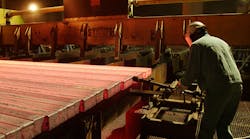America’s factories continued to expand in March, demonstrating momentum in an industry that struggled for the better part of the last two years, according to the latest data from the Institute for Supply Management.
ISM’s diffusion index eased to 57.2 (matching median forecast) from February’s 57.7, which was the highest since August 2014. (Readings above 50, of course, indicate growth.) The measure of orders cooled to 64.5 in March from 65.1, with factory employment gauge climbing to 58.9, the strongest reading since June 2011, from 54.2. Prices-paid index increased to 70.5, the highest since May 2011, from 68.
The manufacturing index, which has increased in six of the last seven months, underscores building optimism among factory managers. In the U.S., the ISM measure of export orders climbed to the highest level since November 2013, indicating improving global demand.
Recent Chinese government figures showed a factory purchasing managers index climbed in March to the highest level since April 2012, while a Markit Economics measure of euro-area manufacturing was the strongest in 71 months.
The ISM’s indexes of inventories continued to contract in March, a sign that production gains will hold up after Federal Reserve factory output data showed the strongest back-to-back advances in almost three years. The highest order backlogs and slowest delivery times for suppliers since 2014 help explain why more manufacturers are reporting that they are adding workers to assembly lines.
The recent pickup in manufacturing has been a bright spot for the U.S. economy during a first quarter otherwise marked by tepid gains in household spending, the biggest part of gross domestic product. On Friday, President Donald Trump touted a National Association of Manufacturers survey showing optimism among members was at a 20-year high.
QUICK HITS: ISM’s production gauge cooled to a four-month low of 57.6 from 62.9, which was the best reading since March 2011. … Seventeen of 18 manufacturing industries reported expansion in March, led by electrical equipment and appliances. … Sixteen of 18 industries reported paying higher raw material costs; there were no commodities reported down in price. … Gauge of supplier deliveries rose to 55.9 in March, the highest since December 2014, from 54.8. … Measure of order backlogs climbed to 57.5, the best reading in three years, from 57. … Customer inventories gauge fell to 47, matching the second-lowest since July 2015, from 47.5
— Vince Golle, with assistance from Patricia Laya, Kristy Scheuble and Michelle Jamrisko
Meanwhile, UK Manufacturing Slows Amid Inflationary Pressures
U.K. manufacturing unexpectedly cooled for a third month in March and may weaken further, according to IHS Markit, which repeated its warning about inflationary pressures.
Its factory Purchasing Managers Index declined to 54.2 from 54.5 in February, above the key 50 level that divides expansion from contraction, but below economists’ expectations for an uptick to 55. A measure of new orders also weakened.
The factory survey compared “favorably” to its long-run trend, according to Markit, with the slowdown centered on consumer-goods producers. While manufacturing probably made a “solid contribution” to first-quarter economic growth, there’s been a definite loss of momentum. That weaker trend is likely to continue into the second quarter, Markit senior economist Rob Dobson said.
In March, the weaker pound helped export competitiveness and firms’ confidence remained high. Bank of England Deputy Governor Ben Broadbent said last month that exporters are enjoying a post-referendum, pre-Brexit “sweet spot” because while sterling has fallen, EU trading arrangements remain in place. That may slowly change after U.K. Prime Minister Theresa May kickstarted the formal process of withdrawing from the EU last week, nine months after the vote to leave.
— Jill Ward



